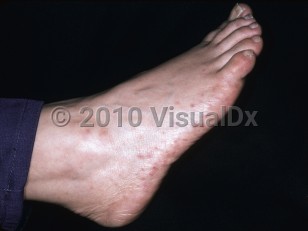Atrial myxoma
Alerts and Notices
Important News & Links
Synopsis

Cardiac myxoma is the most common benign primary tumor of the heart, representing 75% of all primary cardiac neoplastic masses. It is usually diagnosed in adults between the third and sixth decade of life and is more common in women. It can rarely occur in pediatric patients.
Location: 75%-80% of cardiac myxomas are located in the left atrium, 15%-20% are located in the right atrium, and 10% are either biatrial or in the ventricles. Myxomas most commonly develop from the interatrial septum but can also originate from the posterior and anterior atrial walls or the atrial appendage.
Clinical symptoms are variable and are depend on tumor size, location, and mobility. A classic triad of intracardiac obstruction, extracardiac embolism, and systemic / constitutional complaints has been described.
Most cases arise sporadically. Familial cases have been associated with the occurrence of multiple and atypical tumors. Complex familial tumors are part of a rare condition called the Carney complex. Carney complex may manifest with adrenocortical involvement, pituitary-related symptoms, abnormal pigmentation, or multiple neoplasias in the skin, thyroid, testicles, breast, and neural systems. Heterozygous mutation in the PRKAR1A gene, a protein kinase A regulatory subunit-1-alpha gene, on chromosome 17q22-24 has been linked to cases of intracardiac myxoma and to Carney complex type 1. Carney complex type 2 involves a locus at chromosome 2p16, although the gene responsible remains unknown.
Cardiac myxomas can grow rather quickly. Recurrence is thought to be due to inadequate resection, multicentric growth, inheritance, or metastasis and usually happens during the first 4 years postexcision. Sporadic cases almost never recur, while incidence of recurrence for familial cases, Carney complex, and multiple myxomas are 10%, 22%, and 33%, respectively.
Location: 75%-80% of cardiac myxomas are located in the left atrium, 15%-20% are located in the right atrium, and 10% are either biatrial or in the ventricles. Myxomas most commonly develop from the interatrial septum but can also originate from the posterior and anterior atrial walls or the atrial appendage.
Clinical symptoms are variable and are depend on tumor size, location, and mobility. A classic triad of intracardiac obstruction, extracardiac embolism, and systemic / constitutional complaints has been described.
Most cases arise sporadically. Familial cases have been associated with the occurrence of multiple and atypical tumors. Complex familial tumors are part of a rare condition called the Carney complex. Carney complex may manifest with adrenocortical involvement, pituitary-related symptoms, abnormal pigmentation, or multiple neoplasias in the skin, thyroid, testicles, breast, and neural systems. Heterozygous mutation in the PRKAR1A gene, a protein kinase A regulatory subunit-1-alpha gene, on chromosome 17q22-24 has been linked to cases of intracardiac myxoma and to Carney complex type 1. Carney complex type 2 involves a locus at chromosome 2p16, although the gene responsible remains unknown.
Cardiac myxomas can grow rather quickly. Recurrence is thought to be due to inadequate resection, multicentric growth, inheritance, or metastasis and usually happens during the first 4 years postexcision. Sporadic cases almost never recur, while incidence of recurrence for familial cases, Carney complex, and multiple myxomas are 10%, 22%, and 33%, respectively.
Codes
ICD10CM:
D15.1 – Benign neoplasm of heart
SNOMEDCT:
233854003 – Atrial myxoma
D15.1 – Benign neoplasm of heart
SNOMEDCT:
233854003 – Atrial myxoma
Look For
Subscription Required
Diagnostic Pearls
Subscription Required
Differential Diagnosis & Pitfalls

To perform a comparison, select diagnoses from the classic differential
Subscription Required
Best Tests
Subscription Required
Management Pearls
Subscription Required
Therapy
Subscription Required
References
Subscription Required
Last Reviewed:03/08/2020
Last Updated:03/16/2020
Last Updated:03/16/2020

